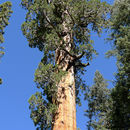More info for the terms:
cone,
monoecious,
seed,
treeGiant sequoia regenerates primarily by seed, although occasionally it
may reproduce naturally by vegetative methods. Giant sequoias up to
about 20 years of age may produce stump sprouts subsequent to injury.
Giant sequoia of all ages may sprout from the bole when old branches are
lost to fire or breakage. Cuttings from juvenile donors root quickly
and in high percentages (up to 94 percent) [
10].
Flowering and fruiting: Giant sequoia is monoecious; male and female
cone buds form during late summer. Pollination takes place between the
middle of April and May. Fertilization usually occurs in August when
the cones are nearly full-sized. Embryos develop rapidly during the
next summer and reach maturity at the end of the second growing season.
Seed production and dissemination: Young trees start to bear cones at
the age of 20 years. Cones may remain attached to the tree for 8 to 12
years and much of the seed will be retained. During the late summer,
however, some seed is shed when the cone scales shrink. Most seeds are
liberated when the cone dries out and becomes detached. Each cone yields
an average of 230 seeds. The average number of cleaned seeds per pound
is approximately 81,000 (200,070/kg). Stored giant sequoia seed remains
moderately viable for many years [
5,
10,
28]. At any given time, a large
tree may be expected to have approximately 11,000 cones. The upper part
of the crown of any mature giant sequoia invariably produces a greater
abundance of cones than its lower portions.
A mature giant sequoia has been estimated to disperse from 300,000 to
400,000 seeds per year. Seed dispersal results from seed falling from
the tree-top, insect and rodent activity, or by cones falling to the
ground. The winged seeds may be carried up to 600 feet (183 m) from the
parent tree.
Seedling development: Giant sequoia seeds germinate best when totally
buried in disturbed mineral soil. April, May, September, and October
temperatures are best for early development. Soil moisture conditions
and seedling survival are generally better in spring than during any
other season. Light conditions are generally best for growing at
one-half full sunlight. Upon germination, the seedling stands 3/4 to 1
inch (1.9-2.5 cm) high, usually with four cotyledons. By autumn,
seedlings have up to six branches and are 3 to 4 inches (8-10 cm) tall.
After the second year, the seedling attains a height of 8 to 12 inches
(20-30 cm) with a taproot penetrating to a depth of 10 to 15 inches
(25-38 cm) [
28].
Growth and yield: Giant sequoia is the worlds largest tree in terms of
total volume. Beyond the seedling stage, giant sequoia unhindered by an
overstory continues to grow at the same rate as its competitors. Yields
of second growth stands dominated by giant sequoia were found to equal
or slightly exceed those of second-growth mixed-conifer stands on the
same site. Lower branches die fairly readily from shading, but trees
less than 100 years old retain most of their dead branches. Boles of
mature trees generally are free of branches to a height of 98 to 148
feet (30-40 m) [
28].

